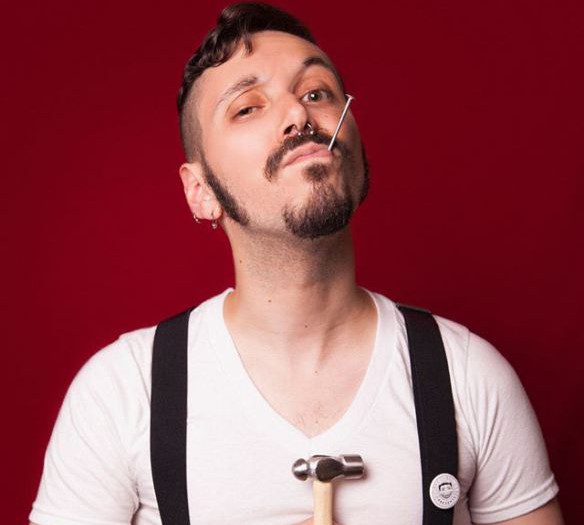
After two years as a sideshow performer, Trick the Bastard is used to receiving feedback from his audiences, but there’s one instance that sticks out most in his mind.
“I can do what you can do,” he recalls a man telling him after witnessing Trick perform an act called human blockhead in which a performer hammers nails or any other implement—straws, screwdrivers, you name it—into their nasal cavity via the nostril.
“All right, I don’t doubt it,” Trick responded calmly. “Here’s the difference: you go up on stage and you’re sticking a nail in your nose. I go up on stage and I’m performing human blockhead.”
For Trick the Bastard, this is an art form and a career.
Back in 2013, the 26-year-old Bay Shore man known as Trick the Bastard—he asked that his real name not be used for this story—lived the typical life of a college student. He attended CUNY Queens College as an English major, spent his weekends listening to music and hanging out with friends in his Summit dorm room and worked as a lighting technician for The YMCA Boulton Center for the Performing Arts in Bay Shore.
That all changed when he saw his first burlesque show.
“So I went to Coney Island and as soon as I got there I thought, ‘Oh my god, this is what I should be doing.'”
“I met a performer, whom I’m now seeing, who sort of reminded me that Coney Island and side show are still alive and well,” he said.
Since then, he left behind academia and made his transformation into Trick the Bastard.
In sideshow, a performer’s on stage persona is what defines them. Therefore, any fledgling sideshow performer’s first step is to find out who they are when they walk on stage.
Knowing this, he spent time developing Trick the Bastard. He made many changes before finalizing the devilish blockhead. At first, his character was meant to be a clown figure with makeup and all.
“My idea was to have this clown figure that fell from grace,” he said. “You know, he had some sort of accident like at a kid’s event or something and now he’s this boozing, smoking, lost my job. And then the acts were going to be really visceral. Just like something you wouldn’t expect a clown to do.”
But he ultimately decided to scrap the idea because he discovered a few fellow performers were doing similar acts. So he kept his name, but changed the story. The final product of Trick the Bastard can be described as a snake oil salesman-like figure who is said to have sold his soul to the devil. His personality also resembles that of a jester or the village idiot.
“[The act] sort of became a whole other thing from there,” Trick says. “Now I’ve got this whole red black and white color motif going on. I’ve got this Satan puppet I use on stage, make a lot of Satan jokes, tell people I sold my soul for the powers of performance that I have—all that kind of goofy stuff.”
“So that’s where the bastard came from,” he continues. “[He] fell from grace, he’s still rude and kind of mean to people. Like, if someone’s heckling me on stage, I’ll berate them. I come out with a beer in my hand, it becomes this whole alternate persona.”
Trick was a born entertainer since his childhood, said his mother, Robin Harvey. So much so that a few elementary school teachers mistook his raw energy for ADHD.
“He is what I would call the class clown,” Robin remembers a specialist telling her. “But she said, ‘I don’t think that that’s a bad thing. The children who don’t have friends who are withdrawn are the ones that you have to watch for. He’s the complete opposite.’
“She said, ‘He does his work, he finishes everything; that is not ADHD,” Harvey recalls. “‘His not being able to sit still is boredom. He finishes his work, and then he’ll tell a joke to somebody next to him or he’ll make funny faces or he’ll tap on the table like he’s playing the drums. And if the teacher tells him to stop, he’ll stop.'”
Later in his teens, he appeared in Long Island productions of The Man Who Came to Dinner and The Importance of Being Ernest, which gave him a solid understanding of character motivation.
Still, he’s the first to admit that becoming Trick isn’t much of a stretch for him.
“It’s like a shade of me,” he said.
“Because when I go up there, the only thing that really changes is the way I talk,” Trick says. “And then, of course, I have lines or jokes or whatever that I’ve written and assumed over time that I wouldn’t say normally that come out because of the character. The only thing that changes what I show to people is that it’s a little more showman, a little more gregarious, a little more over the top.”
LEARNING AND PERFECTING
Performing sideshow requires a lot more than a fleshed-out persona. To complete the package, Harvey underwent intensive training, requiring time, money and patience. Luckily, he had a foundation to build upon.
“For me I started out doing circus stuff like juggling or object manipulation,” Trick says. “I also had an interest in clowning and physical theater.”
In terms of sideshow performing, his first step was mastering one of the most standard routines—the human blockhead, which is now his trademark act. He performs his blockhead routine at shows more than 80 percent of the time, he said.
“Most people start, believe it or not, with human blockhead,” he says. “It’s—I don’t want to say the simplest—but it’s definitely the easiest to execute. But [it’s] one of the more interesting skills to construct an act around because so many people do the same thing. You want to outshine them or make yourself look different from the rest.”
Trick said the routine has become his calling card.
From there, he went on to more challenging skills, such as enduring the bed of nails, walking on glass, performing with fire and doing escape art. But he’s still working on perfecting sword swallowing, the most challenging and dangerous sideshow skill.
Trick emphasizes that in sideshow, “what you see is what you get.” There are no illusions or tricks in this industry compared to magic shows or circus acts.
“If a guy is sticking 22 inches of steel down his gullet, it’s actually happening,” he says. “There’s no tricks involved.”
MAKING A NAME FOR HIMSELF
Although Trick the Bastard has only been on the side show scene for two years, he’s already making a splash.
His girlfriend and burlesque performer, Betsy Propane, is an established name in the New York sideshow and burlesque scene. Trick says he might not have gotten involved if it hadn’t been for her support.
“I think he’s awful,” she jokes after returning from a gig to their art gallery apartment. “I think he’s the worst performer I’ve ever seen in my life.”
While they may be a couple, Propane regards Trick like any other performer she works with. She pays attention to the exhaustive effort he puts into his work—even during a typical morning at home.
“We’ll eat breakfast and he’ll do his exercise,” she recalls. “Then he goes downstairs and throws knives at the board in the basement. Then he goes outside and walks on stilts.
“And it’s like an exercise schedule,” she continues. “It’s almost like being in the military in sideshow. You have to keep revisiting it and getting better with it.”

And it appears that Trick’s effort is paying off big. This summer, Trick the Bastard is the front of house host and inside talker of the Coney Island Side Show—a tremendous honor in the sideshow circuit.
“[Trick] is coming into it at a time when Coney Island needs a strong sideshow figure,” Propane says. “They need someone who cares a lot about the history of sideshow, somebody that knows, somebody that wants to preserve that working. Because it’s not easy being a sideshow performer.”
“COME LOOK AT THE FREAKS”
This past year was saturated in content featuring sideshows, even outside the New York scene. The emphasis? Freak shows.
Screenwriter Ryan Murphy revealed that the fourth season of his hit show American Horror Story was going to be about one of the last freak shows in America during the 1950s. Essentially, the show depicted the end of an era, when the odd, the tattooed, the deformed and the mentally disabled were exploited in the carnival circuit.
“There was an interesting conversation that was sparked in the community when ‘Freak Show’ came out,” Trick says. “And me being a horror fan, I was like, ‘Oh, this is interesting, but also hard for me to swallow.’ There were so many things going on.
“I was like, ‘I don’t want people to think natural born freaks are, you know, horrible or somehow mistreated,'” he recalls. “I also don’t want people to look at sideshow as like some sort of thing you should be afraid of.”
Besides being a performer, Trick is extremely knowledgeable about the history of sideshows, circuses, magic and freak shows. He says that sideshows, specifically freak shows, have always been associated with exploitation. But, he says that these performances gave natural-born “freaks” opportunities for celebrity and monetary success.
“It really started in the early 20th century when people were saying, ‘Hey, we can’t just put this person up on a pedestal,'” he says. “There was an immediate response to the performance, to the ‘freaks,’ to any of the natural-borns. The response was, ‘We can’t find work anywhere else.’ And people who were born naturally ‘freakish’ did very well for themselves monetarily. A lot of them continued to make a living up until the day of their death.”
One film that came out during the height of these freak shows’ popularity attempted to tackle the social implications of these sideshow communities: Todd Browning’s Freaks. Although the 1932 film was meant to be a sympathetic portrayal of natural born freaks—those with some kind disfigurement or unusual condition, such as conjoined twins—audiences found the film to be exploitative and repulsive. As a result, it was nearly impossible to watch it until the mid-20th century.
Today is a different story for natural-born “freaks,” self-made “freaks” and sideshow performers alike.
“It’s a lot more accepted today and that’s great,” Trick says. “There are certain performers who work toward acceptance, work toward the removal of exploitation saying, ‘This is my body, this is my ability and I’m going to show you that I’m a human just like you.'”
Trick cites a performer known as The Black Scorpion, who was born with ectrodactyly malformation—commonly known as lobster claw syndrome—as someone trying to spread awareness.

“He’s a contemporary performer,” he says. “He’s still performing and he works toward showing people ‘I’m not different. Being a freak is a good thing, it’s not exploitation.'”
NOTHING IN LIFE IS FREE
While sideshow performers don’t deal with the same issues as freaks do these days, there is a universal struggle to obtain fair pay.
Trick shares a recent story about his girlfriend’s trip to California when she was approached by a big producer in the sideshow scene.
“The producer was like, ‘You should come out to Cali; I pay my performers very well,'” Trick recalls. “And Betsy was like, ‘Okay, so what’s your standard price?’ And she’s like, ‘Well, we pay a minimum $25 an act.’ And Betsy just looked at her and said, ‘Well, I’m from New York and that’s not how it runs, lady.'”
A big problem in New York is producers trying to lure side show performers in for “exposure” instead of actual wages. There’s an inside joke in the community in regards to that, Trick says.
“We’re no strangers to exposure, trust me,” he says. “If we want people to notice us, we’ll get them to notice us.”
If there is no pay, Trick and his fellow performers have to decline the gigs.
The new trend in side show is performers producing their own shows.
“It’s almost like a ‘look out for your own’ situation,” he says.
CURTAIN CALL
For Trick, his life in the world of sideshow is just beginning. Recently, he and Propane produced a burlesque show inspired by the cult TV show Bob’s Burgers, which resulted in two sold-out performances at Coney Island with more performances in the works.
Trick says he hopes to use his skills in theatre or film gigs. At the end of the day, Trick is just grateful to have the ability to share his passion with the audiences he sees week after week.
“A lot of the things I’m shooting for are happening, slowly but surely,” he says. “It makes me feel like hard work pays off.”




























